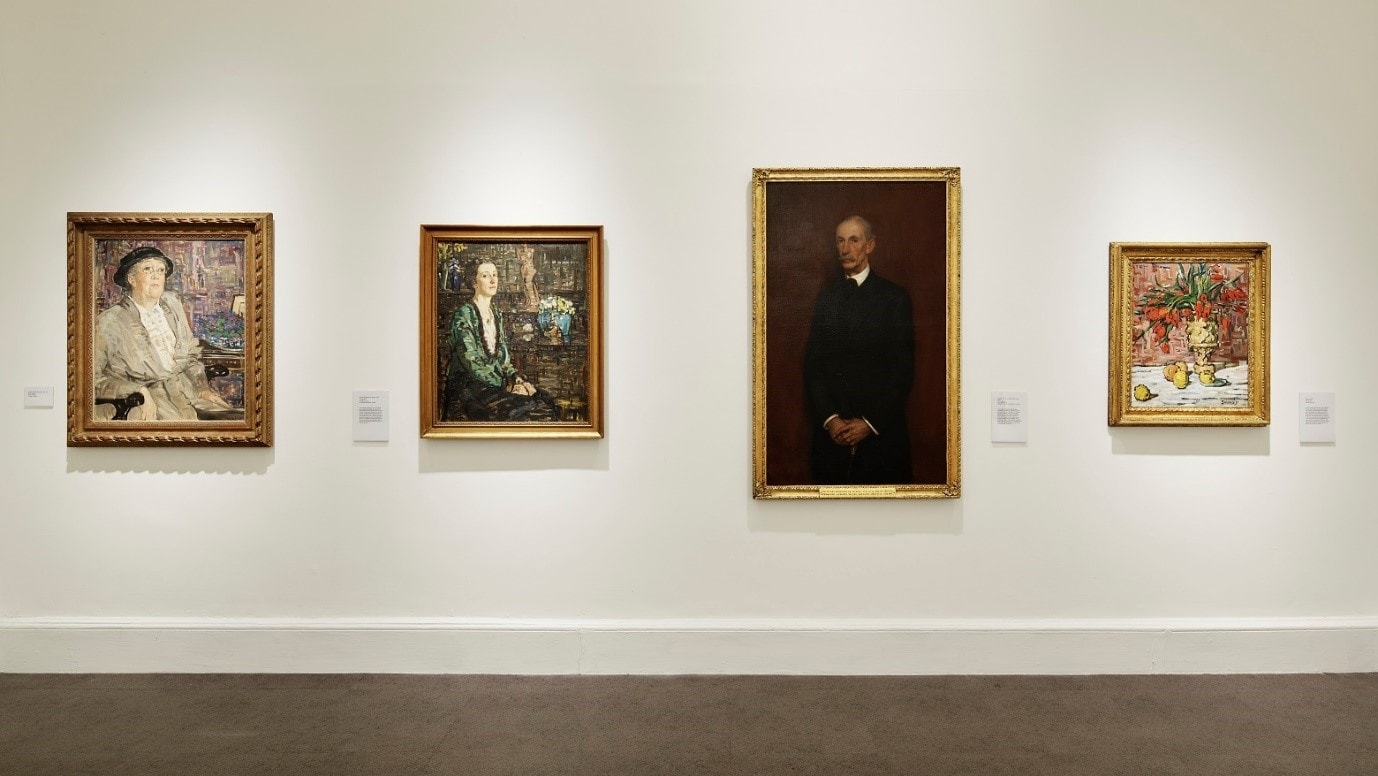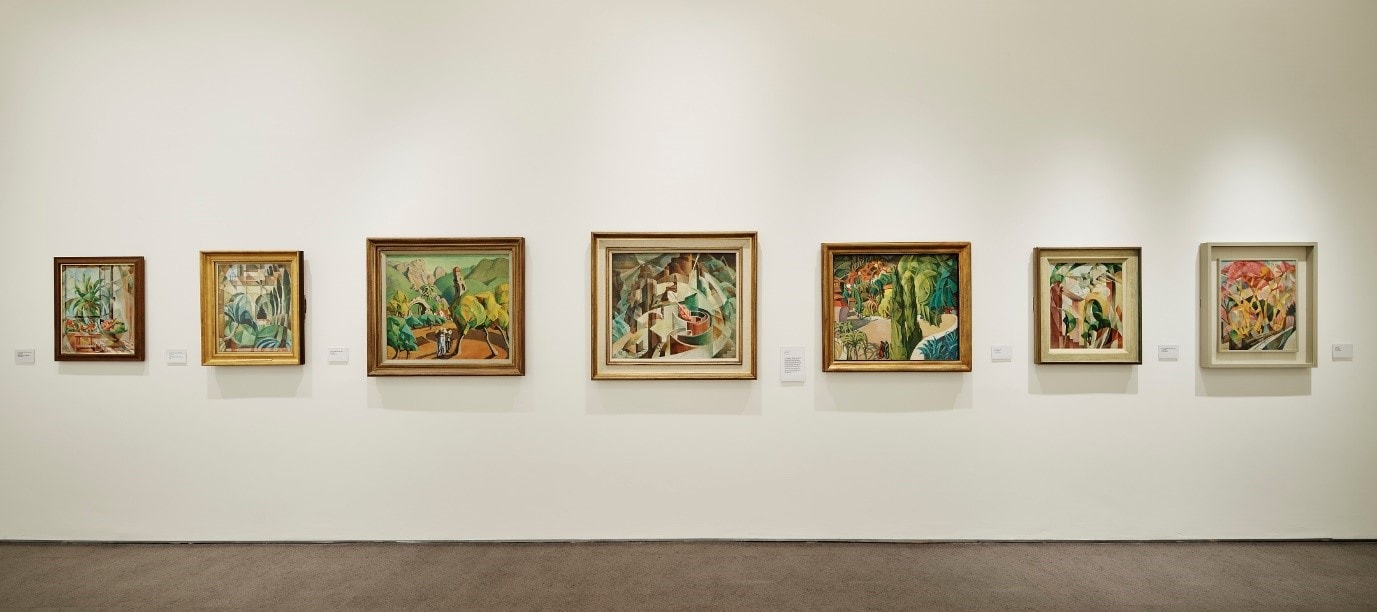Modern art is often defined as the succession of artistic styles from the 1870s into the mid-twentieth century, from Impressionism to Cubism and Surrealism, that moved away from academic tradition. Artists experimented with new materials and techniques to create avant-garde works that could better address the changes in society that came from modernisation and industrialisation.
 Installation View of Mary Swanzy, Voyages, 26 October – 17 May 2019. IMMA, Dublin. Photo by Ros Kavanagh, 2018.
Installation View of Mary Swanzy, Voyages, 26 October – 17 May 2019. IMMA, Dublin. Photo by Ros Kavanagh, 2018.
This breaking of tradition, however, is fixed to specific people in specific spaces and the story of modern art is built on the mythology of the independent male artistic genius. Names such as Pablo Picasso, Salvador Dali, Paul Gauguin, Henri Matisse, Claude Monet, Vincent Van Gogh, are immediately more recognisable than Berthe Morisot, Leonora Carrington, Tamara de Lempicka, Suzanne Valadon, Marie Laurencin, or Mary Swanzy.
Born 1882 in Ireland, Mary Swanzy was an artist whose career spanned seven decades. She travelled extensively, from Belarus to Samoa, and exhibited in Dublin, London, Paris, Brussels, Santa Barbara, and Honolulu, moving beyond and between national borders in her pursuit of modernism. She consciously curated her style to reflect the exhibition space and engaged with multiple modernist aesthetic expressions. Described as ‘Cubo-Futurist’ and a ‘Surrealist working in a Cubist convention’, her work makes it difficult to place her in a linear development of modern art.1
Over the past year, I have focused on Swanzy in the Irish context and presented my research at two separate conferences at NUIG in Ireland. Accounting for Swanzy in the discourse of Irish art history and modernism, following a historiographical model, reveals how the dominant story of the Irish experience in modern art in Ireland has marginalised the artist.
The Irish Museum of Modern Art (IMMA) launched the first retrospective of her work since 1968. Mary Swanzy, Voyages was part of IMMA’s ‘Modern Masters’ series and reveals the desire to mythologise (and reclaim) Mary Swanzy as a ‘Modern Irish Master’ – consequently, she is the ‘unsung hero of modernism’ in Ireland and the ‘first Irish cubist’.2 The catalogue equates Swanzy with Picasso: they both shared ‘the early mastery of the academic tradition’ and ‘continually reinvented their personal styles’.3 Swanzy’s connections to Gertrude Stein and Antonia de la Gandera are heralded as evidence of her independence, radicality, and avant-gardism, and even her proto-feminism and potential queerness. Swanzy’s overall lack of recognition and presence in Irish art history is ‘certainly to do with her gender’ but just as significant are ‘her choices to work outside of Ireland and to be independent of the gallery system diminished the opportunities available to her.’4
The meta-narrative of Irish experience, the desire to establish an Irish school of art, and the tendency to ground art-historical texts in art criticism, have resulted in an intense analysis of Swanzy’s career within Ireland and the validity of her Irishness. Her time in Paris and Samoa do not receive the same amount of research, nor does her non-linear exploration of multiple artistic idioms. Shown in a range of locations, her work was deeply entangled with knowledge production, cultural exchange, and artistic practices across the world.
 Installation View of Mary Swanzy, Voyages, 26 October – 17 May 2019. IMMA, Dublin. Photo by Ros Kavanagh, 2018.
Installation View of Mary Swanzy, Voyages, 26 October – 17 May 2019. IMMA, Dublin. Photo by Ros Kavanagh, 2018.
Through Swanzy, I aim to question the dominance of the masculine narrative of modern art but more significantly, its story and how this is maintained in scholarship and contemporary museum exhibition culture. If stories mobilise power structures, I want to ask what unseen rules of knowledge and art production form the modernist landscape; who belongs and who is outside? More importantly, which knowledges and ways of knowing are legitimised and which are discounted? My goal is to use Swanzy as a feminist case study to undermine the stories of modern art and its gendered tropes in art production and practice, exhibition culture, and subject matter.
In moving this artist beyond the borders of Ireland, Swanzy becomes a marker in the intersections and crossing of modernism and modern art, allowing me to map the trajectories outside of and in-between known and unknown modernist spaces. Through her extensive and impressive travels, I can engage with transnational modernism and its global cartographic rules.
Stories are powerful because, like maps, they mobilise the histories and geographies of power. Stories tell us who belongs and who does not. ‘When we look to the past to make sense of the present and to shape the future, it matters whose voice and whose story we chose to listen to.’
References:
- Seán Kissane, ‘IMMA presents Mary Swanzy, Voyages’, YouTube, 2 November 2018. Accessed 11 March 2019.
- See the following: Aidan Dunne, ‘Mary Swanzy: From strait-laced girl to first Irish cubist’, The Irish Times, 19 January 2019. Accessed 11 March 2019. Liz Cullinane, ‘Mary Swanzy – The unsung hero of Irish modernism’, Irish Independent, 21 October 2018. Accessed 5 March 2019. Tom Walker, ‘Mary Swanzy – a modern Irish master?’, Apollo, 21 November 2018. Accessed 5 March 2019.
- Seán Kissane, ‘IMMA presents Mary Swanzy, Voyages’, YouTube, 2 November 2018. Accessed 11 March 2019.
- Ibid, 177.